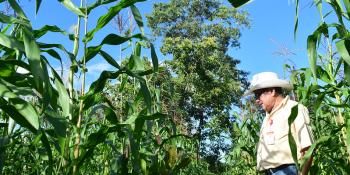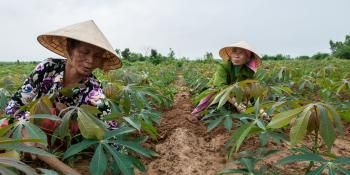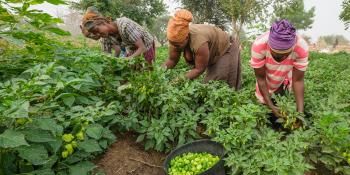Women take the lead on climate-smart agriculture

Rural women are crucial to agricultural productivity, sustainability, and they are the backbone of food security for their families and communities.
In the last few years, the CGIAR Research Program on Climate Change, Agriculture and Food Security (CCAFS) Latin America has worked in four different Climate-Smart Villages (CSVs) across the region to strengthen those communities as they increasingly face the challegens climate change poses, and has focused on providing equal opportunities for women and men within agriculture. For this year’s International Women’s Day, we took the opportunity to talk to two Colombian farmers in Cauca Climate-Smart Villages to find out how climate-smart agriculture fit into their lives.
La Mercedes community, Cauca is baking under the sun when we reach the Riveras’ house. Flowers hanging all around shelter the porch; some chicken are pecking at the chopped green plantains on the ground. Ana Rivera sits us down in her breezy kitchen; her face often blooms into a smile, her eyes are dark and warm. Her mango smoothie is fabulous.
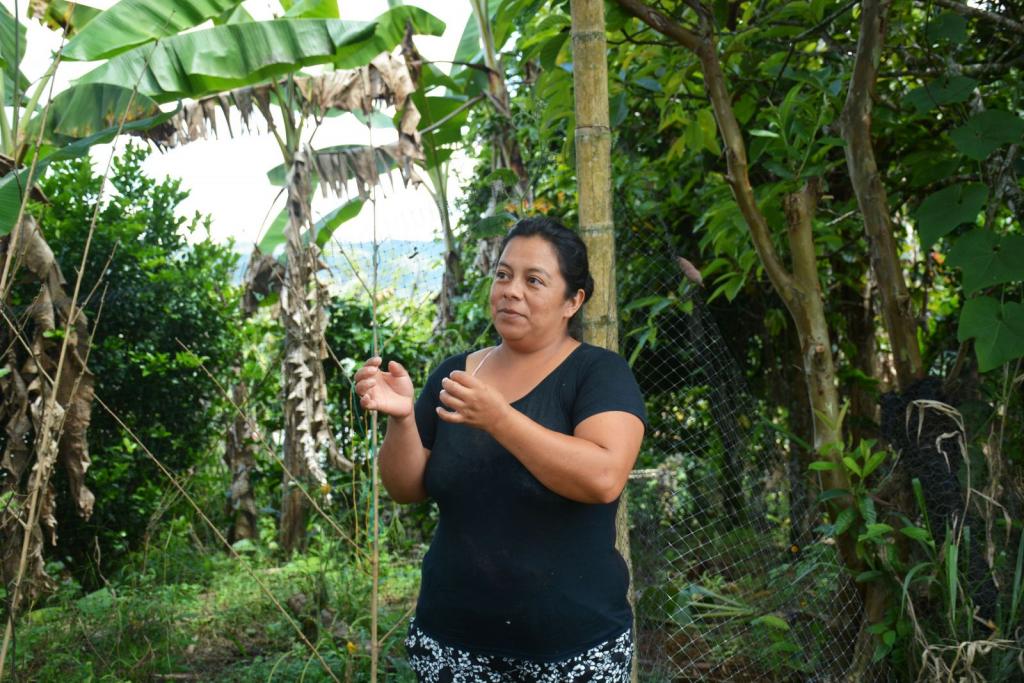
Ana Rivera, an experienced farmer in Cauca CSV, gives us a tour of her garden. Photo: Alexandra Popescu (CCAFS)
Ana Rivera, 38: I was born here, on my parents’ farm, but was away for a while throughout school. I finished my education and came back when I was around 17. At 19 I met my husband, who already had some land from his family. This land, where we are now, I bought it after working on my own and saving up. We own another patch a land not far from here.
My husband had coffee and sugarcane crops. Me, almost nothing. But we were daytime workers, “jornaleros”. Now it’s been 18 years since we’ve got the house.
Now we have spare produce we sell to our neighbors and around the community. It’s not a lot of money but now we’re never short of cash.
I’ve been for two years in the project on climate-smart agriculture (CSA). That’s why I started putting more work into our home garden; I’ve always had it, but I always focused on my coffee and sugarcane because these are our main crops. I’ve heard Ecohabitats Foundation was organizing farmers’ schools on how to build home gardens so I went to about eight of them. I chose the circular garden because I thought it was beautiful. They all work on the same principles, so I just liked that one. Last year in January we improved the garden and we covered it, which helped us produce more as our greens were sheltered. Before I had coriander, oregano, lettuce, just a bit for the house. Now we have spare produce we sell to our neighbors and around the community. It’s not a lot of money but now we’re never short of cash.
We also eat more things. Before I would never buy produce from the market, like spinach. If I didn’t have it in the garden, I just didn’t buy it. Now, one dares to try out more things. For example, I never thought carrots would grow here but they do. The same for beetroot. I make spinach soups and colorful salads for my family. But my favorite is chard. I didn’t use to eat simply because I did not want to buy it.
It’s all organic. I’ve learnt from my grandparents to use the coffee cherry as a fertilizer, once it’s well fermented. But we’ve also learnt how to prepare other organic fertilizer within the climate-smart project. I have my notebook where I write down all the recipes. It’s really easy, one can convert to organic agriculture quickly.
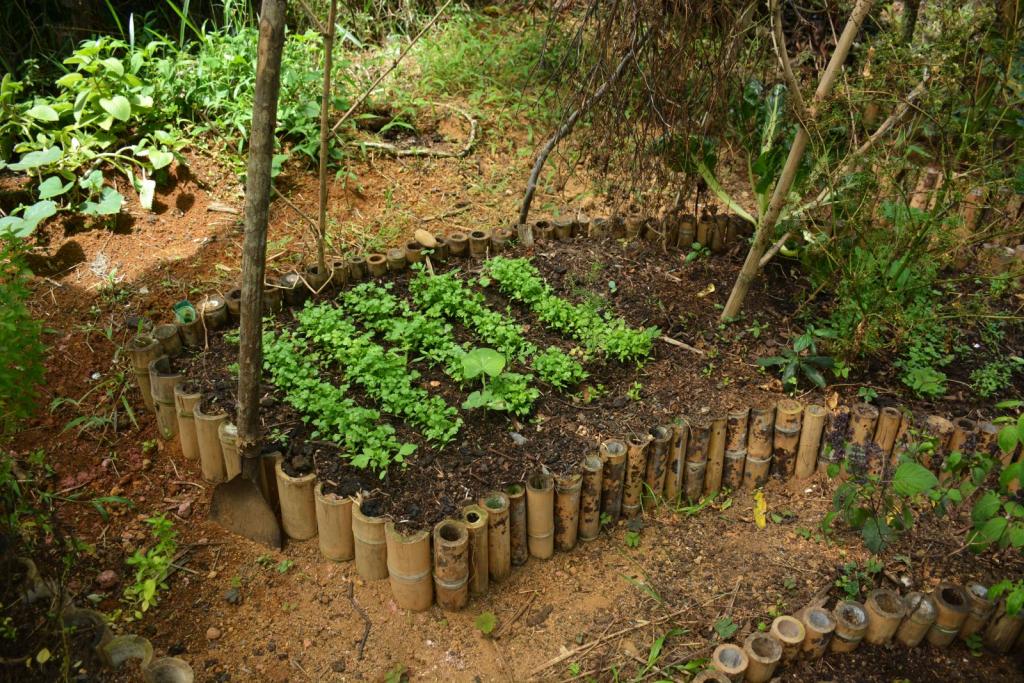
Part of Ana's circular home garden, a product of climate-smart agriculture in Cauca CSV, which has helped her family diversify their diet. Photo: Alexandra Popescu (CCAFS)
We’re also harvesting water. Before, in times of drought we had to carry it for anything we might have needed, including irrigation. And sometimes we don’t have rain for seven months. I’m also using a pluviometer now, which is really helpful to see how we can help the crops or how we deal with the harvest.
As a woman, usually everything falls on your shoulders
There aren’t many difficulties. You need to learn and that actually helps with saving time. My kids are helping – the boy (16) with the harvest and my daughter (11) with selling at the market. My husband changed since the start of the project. As a woman, usually everything falls on your shoulders – household and working the field too. You’re the first to wake up, make breakfast, lunch and dinner; bring food to the field and stay there and help; then the house again. But my husband saw that in the farmers’ schools there were men, women, even children and saw the usefulness of the initiative so his attitude shifted. Now he even helps me mop the floors on Sundays.
Further up the hill we reach Daniela’s house, overlooking a large greenhouse, its white cover reflecting the bright afternoon sun. Still a teenager, Daniela speaks about agriculture and her involvement in the CSV with confidence.

Daniela Campo, inside her newly-built tomato greenhouse that will help her finance her studies. Photo: Alexandra Popescu (CCAFS)
Daniela Campo, 17: I’ve been working in agriculture since I was a child. It’s just me, my mother and my brother. We’ve been mainly growing coffee, sugarcane and bananas, like most people around here. My mother has 3 hectares of coffee trees and we wanted to change the way we worked. Thanks to Ecohabitats Foundation and CCAFS we first introduced drip irrigation and that was just the start for more projects. I have been working with them since I was 14.
I took part in various workshops within the Climate-Smart Village initiative. I went to Bolivar and talked to other young people about CSA practices and what agriculture means to me.
I took part in various workshops within the Climate-Smart Village initiative. I went to Bolivar and talked to other young people about CSA practices and what agriculture means to me. I like the rhythm of the field; you have flexibility, peacefulness, and it’s a safe environment. Also the community here is very united, people help each other.
In Jamundi, I also learnt to prepare organic fertilizers; it’s very important to shift to organic, there are too many chemicals used.
I want to study environmental engineering at the university. But it’s very expensive to support myself in the city. So when I finished high school, Ecohabitats proposed I financed my studies with resources from a climate-smart agriculture project: a tomato greenhouse. It’s just down there, below, it was finished a month ago, in the first week of February. It was planned to be 300 sqm but it’s actually 400, because we had plenty of space down the slope. It took about a week and eight people's help to get it done.
We will start sowing soon. About two weeks ago we prepared the fertilizers. We will use only organic fertilizers for the tomatoes and it will take about 3 months until we can have our first harvest. Then I can start saving for university. It’s not that I want to be in the city; I want to continue my education to have the knowledge and means to help my mother on the farm here. She still needs to raise my brother and I want her to have an easier life.

Daniela explains to CCAFS Latin America how organic fertilizer preparation works. Photo: Alexandra Popescu (CCAFS)
I'd like to see all the women working at home to get more and more involved in the farmers' schools
People are active in the CSV. They are now growing and selling organic coffee within an initiative called "Café y Clima" and the project aims to also help other young people finance their studies. I am also thinking of assigning a coffee lot for that project.
I’d like to see all the women working at home to get more and more involved in the farmers’ schools – to learn how to grow new crops in their home gardens, how to prepare the fertilizers, their own tiny bio factories. There is no cost. And there are many opportunities here for women interested in agriculture.
Read more:
- Info note: Achieving Gender Equality and Women’s Empowerment in Smallholder Adaptation: Lessons from IFAD’s Adaptation in Smallholder Agriculture Programme
- Blog: Researchers support women as they #PressForProgress this International Women’s Day
- Blog: Woman to woman: Women scientists share how their work is helping women and girls succeed in agriculture
Alexandra Popescu is the communication officer for CCAFS Latin America.

